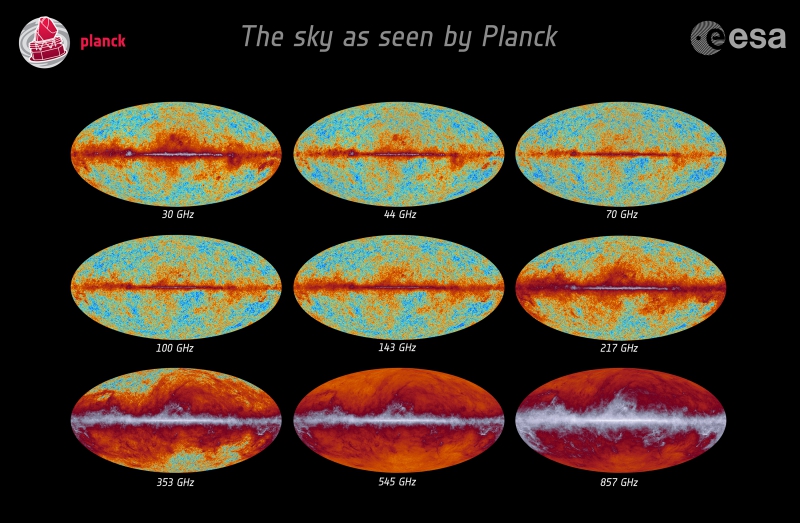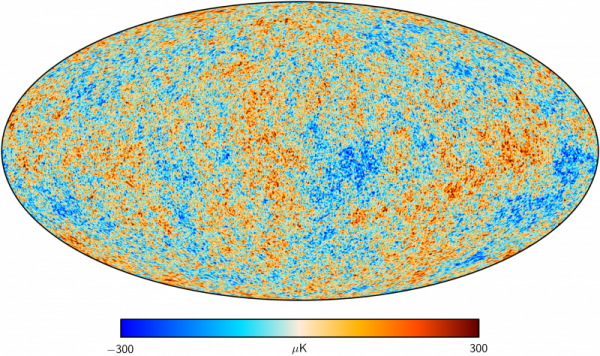How PolyChord was originated by looking at high dimensional problems relating to complex information seen by the Planck satellite

Figure: Planck frequency channel maps. (Image credit: ESA and the Planck Collaboration.)
The cosmic microwave background (CMB) provides us with our earliest view of fluctuations in the infant Universe. Analysis of the statistical properties of the CMB fluctuations has allowed us to answer questions such as what is the composition of the Universe, and what are its large-scale geometric properties. Moreover, the CMB has played a pivotal role in developing our understanding of the origin of primordial fluctuations, now thought to result from the stretching of quantum fluctuations from microscopic to cosmic scales during a brief period of cosmic inflation.
In order to gain a view of the “original” state we needed to subtract some of the frequencies shown above in A to produce the “clean” map as seen below in B.,That is how PolyChord was invented, as a tool needed to solve very complex data problems in high dimensions.

Figure The view after data has been cleaned using PolyChord. (Image credit: ESA and the Planck Collaboration.)
The main goal of Planck was to measure the temperature anisotropies of the CMB to the limit set by astrophysical foregrounds, thereby extracting essentially all of the cosmological information in the primary temperature fluctuations. Further goals were to measure accurately the polarization of the CMB, to determine the properties of a large number of extragalactic sources (including galaxy clusters), and to probe the properties of dust, gas, and magnetic fields in our Galaxy. KICC has been one of the leading institutes in Planck, by hosting one of the main advanced data processing centres and by obtaining some of the primary scientific results.
The cosmic microwave background (CMB) provides us with our earliest view of fluctuations in the infant Universe. Analysis of the statistical properties of the CMB fluctuations has allowed us to answer questions such as what is the composition of the Universe, and what are its large-scale geometric properties. Moreover, the CMB has played a pivotal role in developing our understanding of the origin of primordial fluctuations, now thought to result from the stretching of quantum fluctuations from microscopic to cosmic scales during a brief period of cosmic inflation.
Immediately following the discovery of the CMB, experimenters began a search for temperature variations (anisotropies) across the sky. The anisotropies were finally discovered by the COBE satellite in 1992 (for which Mather and Smoot were awarded the 2006 Nobel Prize for Physics). COBE was followed by NASA's WMAP satellite, which reported its first results on the CMB anisotropies in 2003 and its final results in 2012. WMAP was pivotal in defining a new era of precision cosmology. For the first time, the values of key cosmological parameters characterising the composition, geometry, size and age of our Universe, were measured to high precision. The most recent full-sky data on the CMB fluctuations comes from ESA’s Planck satellite. Planck was launched in May 2009, with the goal of making the definitive measurement of the primary temperature anisotropies, allowing tests of the standard cosmological model with unprecedented precision. The first cosmological data products and papers were released in March 2013, based on 15.5 months of temperature data. More recently, a second release included the temperature data from the full mission (over five complete surveys of the sky for the High Frequency Instrument) and a first and partial analysis of the polarization data (which provides complementary information to the temperature anisotropies). The production of Planck data products, and their analysis and interpretation has been a major focus of CMB work at KICC.
KICC researchers are also involved in observational CMB work with the AMI telescope, operated by the Cavendish Astrophysics Group. They have also been active in developing post-Planck CMB satellite missions, targeting the large-angle polarization signature of primordial gravitational waves and the small-scale imprints of gravitational lensing by large-scale structure; recent proposals include COrE, PRISM, and COrE+.
A further frontier area for CMB research is the frequency spectrum. This was measured to be very close to a blackbody by COBE/FIRAS, but small spectral distortions are expected from standard processes in the early Universe — measuring these would be a further stringent test of the standard cosmological model, as well as probing the primordial fluctuations on smaller scales than can be accessed with other cosmological probes. There is also great discovery potential, with many non-standard sources of energy injection producing observable imprints in the CMB frequency spectrum. KICC researchers pioneered some of the most detailed calculations of these imprints, and are involved in the design of experiments such as PIXIE, PRISM, and APSERa to search for them.
Theoretical work on the early Universe at KICC is currently focused on trying to understand how the universe got populated with particles after the end of inflation (reheating/the hot big bang), observational consequences of phase transitions in the early universe and the generation of the matter/anti-matter asymmetry observed in our Universe.